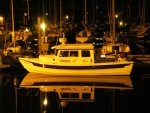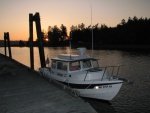Hi Mike,
Yes, There are a lot of folks who use CPAP on their boats, RV's, commercial air flights and I know of one person who used a CPAP off his motorcycle. (Yes the moto battery was modified --read enlarged some -- but he was able to do it without additional charging accesseries like solar or plugging in somewhere.)
For those who are still wondering. CPAP = Continuous Positive Air Pressure, and it is treatment for Obstructive Sleep Apnea Hypopnea Syndrome. There are variations called BiPAP or APAP and there are other types of apneas.
I use CPAP, and would not consider going without for overnight. My particular set up is an older Respironics REMstar, which is rated at 1.0 amps at 110VAC but it has a direct 12 volt plug-input so I can run it directly off a 12VDC cig plug on the boat. For a while we were running to CPAP's each night, (same models). Typical run time is 7-8 hours each. Neither device is running a humidifier, and the batteries on the boat are Group 27's (2) run through a 1-2-Both switch on "Both". Battery voltage generally drops from 12.7 to 12.3 or 12.4.
Running twin 40 Yamaha's, the batteries are back up after about an hour of cruising. YMMV.
There are multiple combinations of stand alone batteries, adapters and accessory chargers available. What you use will depend on what company made your machine. The most common are ResMed and Respironics. There are others, DeVelbis, Fisher Pykel, GoodNight are common alternatives. Respironics machines run on 12 VDC, Respironics run on (I believe) 18 volts, so it requires a "brick" to adjust the voltage.
For the best device for your machine, it is best to go to your DME (durable medical equipment) provider and they will connect you with the machine manufacture for their approved device. Obviously there are alternatives, but the CPAP is a medical device and your health depends on it's proper function and your effective use.
As mentioned, you will probably not want to use the humidifier heater as it will suck up a huge amount of power. Some use them with the water in and unheated. Some (as I do) opt to not even include the humidifier in the circuit. That is probably not best for the respiratory system, but it is still functional CPAP and will get the job done.
I hope that helps.
Harvey
SleepC:moon



